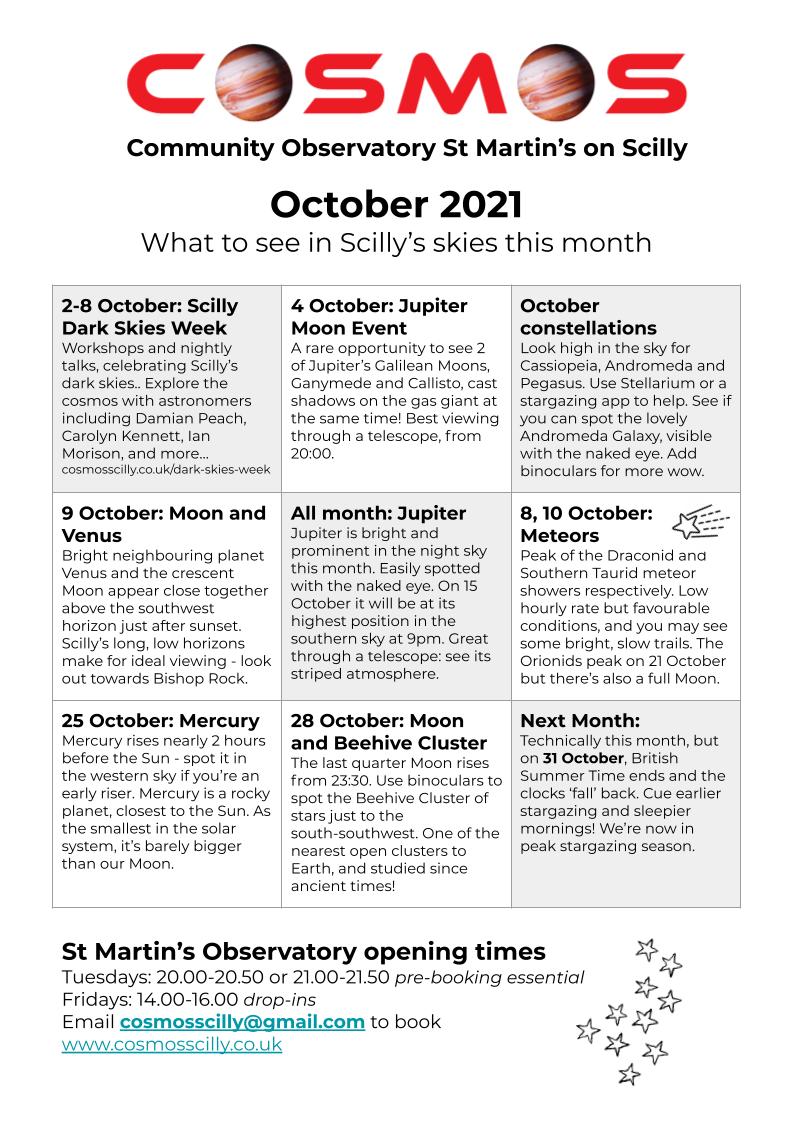|
A version of this piece appears in Scilly Now & Then's October/November issue, on sale locally.
As you’re reading this, we will have completed our first ever Scilly Dark Skies Week, where we welcomed some fantastic speakers from many fields of astronomy, to our observatory on St Martin’s. With the generosity of spirit we know so well on Scilly, they shared their expertise with keen learners of all levels of experience. The brilliant thing about astronomy as a pursuit is that you can never know it all. And so we keep learning together. It’s always been our aim to nurture a community of astronomers both residents and visitors on Scilly, and our Dark Skies Week is another step towards that. Our speakers included Cornwall-based archeo-astronomer Carolyn Kennett who wowed us with incredible connections between some of Cornwall & Scilly's pre-historic monuments and the Sun. It's mind-blowing that we're just the latest in a long, long history of humans in our part of the world, gazing up at the stars! Damian Peach joined us via the medium of Zoom to talk us through the art of astrophotography , whose images have regularly been shortlisted in the Astronomy Photographer of the Year competition. COSMOS regulars Mark Holmes and Ian Morison gave great talks, grounding us in the basics of astrophotography, the importance of community observatories (though Ian did blow a few more minds with his talk on the Milky Way and galaxies beyond!). We were so lucky to have them both here all week to help out and share their expertise - they have both been here from the start, before COSMOS was 'a thing'. While the weather didn't always play ball - it's October in the UK, after all - we did get some decent telescope time, with stunning views of Jupiter and Saturn. We were delighted to have had Scilly Dark Skies Week listed as one of the few must-see events in The Sky At Night Magazine this month. Whether you made it or not, we hope the event will run annually, bringing Scilly astronomers together to enjoy interesting talks and dark October skies. To October skies. As the islands calm down for the year, the skies suddenly wake up. Darkening evenings and lights-on-in-the-mornings: whatever the Earth’s orbit may be doing to our circadian rhythms, there can be one thing to be sure of, more stargazing! (The prevalence of cloud is another matter; we can but watch the weather forecast, or, on Scilly, look out of the window and grab our moments.) There are a couple of meteor showers to watch out for in October. The Taurids peak towards the beginning of the month but continue to the middle of October – by no means prolific, up to 5 per hour but if you do catch one, you could witness some long, bright trails! By 21 October, we’re into the peak of the Orionids, but unfortunately a big, bright Moon might inhibit some seeing. The likelihood of observing this or that isn’t something that should stop you grabbing any clear night on Scilly to look up, as you will be awed by the sheer number of stars you can see; the Milky Way, coursing above, remains observable for at least the next month. Jupiter and Saturn shine brighter than any stars before midnight, in the south-western sky. Jupiter is much the brighter and will appear lower in the sky. Look slightly above and to the right for ringed Saturn. Add binoculars and you might get a sense of those magical ice and rock rings that make Saturn such a popular planet in our imagination. It’s been the ‘wow’ moment for many of our summer visitors, seeing these rings through a powerful telescope. High in the night sky at the moment, locate Cassiopeia, her wonky W shape, supposed to bring to mind the vainest of vain Greek queens reclining on her throne (astronomers have vivid imaginations). To the east of Cassiopeia, towards the constellation of Andromeda, you may – on a dark night – be able to make out the Andromeda galaxy with the naked eye, as a hazy patch of light. Andromeda is our nearest galaxy, at approximately 2.5 million light years away – that means any light you can see tonight is 2.5 million years old. Isn’t that something? Finally, British Summer Time ends on 31 October, so we welcome longer and longer nights – all the better for stargazing. Let us know what you’re looking at from wherever you are.
0 Comments
Here's what we're looking at in our skies this month! To download this as a PDF, click here.
|
BYCharlie Payne POSTS
September 2024
|


 RSS Feed
RSS Feed